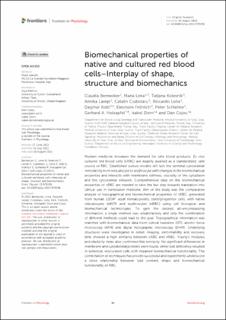| dc.contributor.author | Bernecker, Claudia | |
| dc.contributor.author | Lima, Maria | |
| dc.contributor.author | Kolesnik, Tatjana | |
| dc.contributor.author | Lampl, Annika | |
| dc.contributor.author | Ciubotaru, Catalin | |
| dc.contributor.author | Leita, Riccardo | |
| dc.contributor.author | Kolb, Dagmar | |
| dc.contributor.author | Fröhlich, Eleonore | |
| dc.contributor.author | Schlenke, Peter | |
| dc.contributor.author | Holzapfel, Gerhard | |
| dc.contributor.author | Dorn, Isabel | |
| dc.contributor.author | Cojoc, Dan | |
| dc.date.accessioned | 2023-01-26T09:51:22Z | |
| dc.date.available | 2023-01-26T09:51:22Z | |
| dc.date.created | 2022-11-10T12:18:26Z | |
| dc.date.issued | 2022 | |
| dc.identifier.citation | Frontiers in Physiology. 2022, 13 . | en_US |
| dc.identifier.issn | 1664-042X | |
| dc.identifier.uri | https://hdl.handle.net/11250/3046503 | |
| dc.description.abstract | Modern medicine increases the demand for safe blood products. Ex vivo cultured red blood cells (cRBC) are eagerly awaited as a standardized, safe source of RBC. Established culture models still lack the terminal cytoskeletal remodeling from reticulocyte to erythrocyte with changes in the biomechanical properties and interacts with membrane stiffness, viscosity of the cytoplasm and the cytoskeletal network. Comprehensive data on the biomechanical properties of cRBC are needed to take the last step towards translation into clinical use in transfusion medicine. Aim of the study was the comparative analysis of topographical and biomechanical properties of cRBC, generated from human CD34+ adult hematopoietic stem/progenitor cells, with native reticulocytes (nRET) and erythrocytes (nRBC) using cell biological and biomechanical technologies. To gain the desired all-encompassing information, a single method was unsatisfactory and only the combination of different methods could lead to the goal. Topographical information was matched with biomechanical data from optical tweezers (OT), atomic force microscopy (AFM) and digital holographic microscopy (DHM). Underlying structures were investigated in detail. Imaging, deformability and recovery time showed a high similarity between cRBC and nRBC. Young’s modulus and plasticity index also confirmed this similarity. No significant differences in membrane and cytoskeletal proteins were found, while lipid deficiency resulted in spherical, vesiculated cells with impaired biomechanical functionality. The combination of techniques has proven successful and experiments underscore a close relationship between lipid content, shape and biomechanical functionality of RBC. | en_US |
| dc.language.iso | eng | en_US |
| dc.publisher | Frontiers Media | en_US |
| dc.rights | Navngivelse 4.0 Internasjonal | * |
| dc.rights.uri | http://creativecommons.org/licenses/by/4.0/deed.no | * |
| dc.title | Biomechanical properties of native and cultured red blood cells–Interplay of shape, structure and biomechanics | en_US |
| dc.title.alternative | Biomechanical properties of native and cultured red blood cells–Interplay of shape, structure and biomechanics | en_US |
| dc.type | Peer reviewed | en_US |
| dc.type | Journal article | en_US |
| dc.description.version | publishedVersion | en_US |
| dc.source.pagenumber | 15 | en_US |
| dc.source.volume | 13 | en_US |
| dc.source.journal | Frontiers in Physiology | en_US |
| dc.identifier.doi | 10.3389/fphys.2022.979298 | |
| dc.identifier.cristin | 2071774 | |
| cristin.ispublished | true | |
| cristin.fulltext | original | |
| cristin.qualitycode | 1 | |

